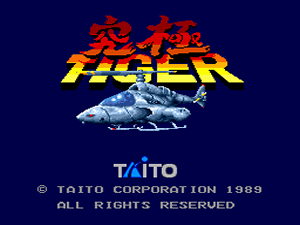Checkpoints ON
1 Difficulty level
10 Stages (loopable)
Ship speed fixed
- - - - - - -
Developed by Toaplan
Published by Taito in 1989
It just occurred to me that this game – or variations thereof – might be one of the most ported arcade vertical shmups of its generation. As such, an entry for the PC Engine was a sure thing back in the end of the 80s, courtesy of Toaplan's publishing partner Taito. The best thing about it is that this version of Kyūkyoku Tiger has passed the test of time due to the great fun factor and decent challenge for 16-bit standards. And it's faithful to its Japanese original incarnation, which means it's got checkpoints. Some of them are a tad hard to recover from and you might as well get sent back even further in the level depending on how and where you die again.
The classic gameplay that inspired dozens of similar shmups is here for everyone's enjoyment. Shoot with button II, drop bombs with button I. Face wave after wave of incoming enemy choppers while dealing with turrets and tanks ready to take you by surprise as you move left and right, sweeping rewards in the form of kills and ground stars that are worth 3.000 points each at the end of the level (since the start of the stage or the last time you died, that is). Just remember to take a turbo controller with you on the ride, the game lacks autofire and you totally need it for button II.
Opening screen
As I mentioned above, game mechanics in Kyūkyoku Tiger are very simple. Overcoming the odds and winning the battles against the bosses is a different matter altogether. In order to stand a chance you're allowed to collect power-up items released by destroying this specific green carrier that always fires two spreads of three bullets when entering the screen. The blue S is responsible for increasing firepower, while the colored circle serves as a weapon type switch that cycles in the following basic order: → red (forward vulcan shot) → green (thin laser) → blue (spread shot) → yellow (4-way cross shot) → red → ... Every once in while a B will appear for an extra bomb, with a few more bombs coming out of nowhere from the bottom of the screen seemingly at random. Yes, talk about a token of kindness from this particular port! Finally, if you manage to play well enough one of the ground stars in selected stages will eventually be replaced by a 1UP item for an extra life.
Even though all stages are a mix of city, desert, ocean and harbor, and the second half of the game pretty much mirrors the first half with minor but important changes, this classic shooter never feels repetitive because it keeps players on their toes all the time. There comes a time when you realize brute force is the best ally against a fiercer attack from the enemy, as in those huge planes that cross the screen either from top to bottom or appearing from behind. Blink and you're dead meat, go greedy on bombs and you might regret it. Even with the tamed difficulty that's characteristic to console ports there's no stint of calm anywhere.
One of the distinctions of the PC Engine version, which is shared with Twin Cobra on the NES, is that when maxed out the horizontal streams of the yellow weapon acquire a slight homing ability that makes it a lot more useful than in the original arcade game. Not that it will by any means surpass the efficiency of the blue spread, since that’s still the best choice from start to finish once you get comfortable with the seemingly erratic enemy behavior and learn how to circumvent the lines of tanks that often catch players off guard. Those sniping bastards.
Raiding sea and land for great justice
(courtesy of YouTube user VGDBbr)
Note that bosses do not time out in this version, so the trick to evade the 7th boss does not apply here; you have to destroy both tanks, preferably one at a time so that they don’t overlap their attacks. Besides the ground stars for 3.000 points each at the end of the stage, players can also boost their scores by collecting colored weapon items (each one is worth 2.000 points). Scoring higher is mostly a matter of not dying, although the twin turret boss of stage 10 can be milked for as long as you have extra lives left. Speaking of which, it’s possible to inflate the life stock due to the generous extend scheme that starts with 50.000 points, continues at the 100.000 mark and goes on for every 100.000 points afterwards. Secret tip: as soon as the credit starts move to far left and bomb to win three extra lives.
Aesthetically it can be said that Kyūkyoku Tiger for the PC Engine succeeds both graphically and aurally. Unlike many other shmups in the platform, there’s a good balance between music and sound effects. Exclusive to this port, a brief ending sequence awaits all players who complete the first loop. The only difference I noticed in the second round is the increased speed of enemy bullets, which makes both survival and checkpoint recovery somewhat harder. Since there’s no score buffering of any kind, remember to pause at once after you die your last life if you want to get note of your final score.
Below is my best result, dying in stage 2-4.



Nice review! Keep the Turbo-Grafx/PC Engine reviews coming!
ReplyDelete